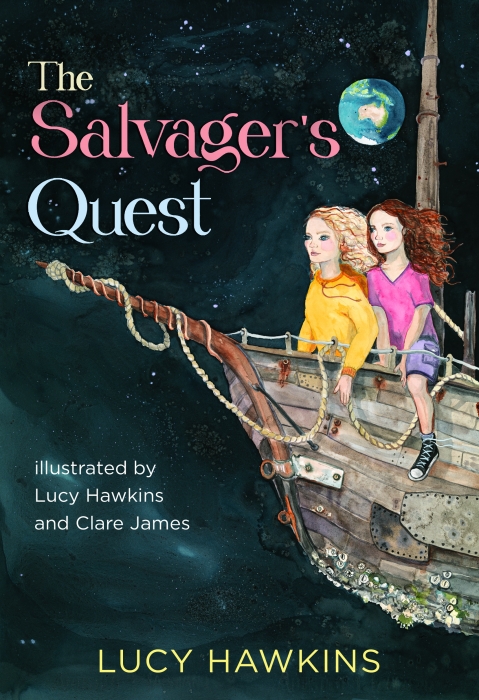Climate change is scary. For adults, let alone kids. We’re scared by things that are out of our control and if we don’t think something is fixable then we believe there’s no point trying.
I spoke to several friends asking how they tackle the subject with their children and while they all imparted varying amounts of information to their kids, they all broached the subject with positivity, that we can make a difference.
To inspire kids to look after their planet we need to give them bite-sized do-able jobs that become as part of their daily routine as putting on their clothes.
Each morning at my daughter’s Kindergarten, they acknowledge the Wurundjeri People as the traditional custodians of the land and they talk about how we can care for the land, for animals and people. They recycle and compost, and the children help them. They grow their own fruit and vegetables which they use in their meals. They have chickens and share the surplus eggs with the community.
The land we live on is an on-going discussion and they ask the kids to share their ideas on how they can care for it. The kids shout out, “Pick up your litter!” God forbid you drop something at our house, my daughter will make you extremely sorry.
Because of the amazing education they get at Kinder it hasn’t been hard to implement it at home. When we give our kids jobs we also tell them why they’re doing them:
- They pick up litter so animals don’t eat it or so it doesn’t end up in the ocean and kill sea life.
- They plant trees which give us oxygen and we use less paper so less trees are cut down.
- They walk instead of get driven as much as possible as cars pollute the air we breathe.
- The kids don’t waste things as they know there isn’t an endless supply and we don’t want to run out, so for the most part they wear 2nd hand clothes.
- They scrape their food scraps into the chicken’s tub or the compost bin.
- They turn lights off when they leave a room, sometimes when I’m still in it.
My daughter’s school has the same approach with an emphasis on the land and the children’s footprints. It isn’t until year 5 or 6 that kids are taught about rising temperatures. At that age they are given the responsibility of forming their own, ‘Sustainability Ministry’, a delegation of kids in charge of green policy at the school. This year they’ve created, “Waste-Free Wednesdays’, where lunch boxes should contain as few items as possible that must be thrown away. It’s stuck, we don’t use packaging in any day’s lunch box now.
It’s really important to give kids some agency over the situation rather than this sense of impending doom as it’s contributing to youth mental illness. The ‘Mental Health and our Changing Climate: Children and Youth Report 2023’, report found that, ‘Youth are increasingly feeling frustrated and betrayed by poor governmental response to climate change. However, despite rampant climate anxiety, many are motivated to be a part of climate solutions as evidenced by a recent surge in marches and protests.’
Fridays For Future is a youth-led and organised global climate strike movement that started in 2018 when then 15 year old Greta Thunberg began a school strike for climate. In 2021, 150,000 students around Australia went on strike for climate action. Could that act of doing something, of meeting other like-minded kids, of seeing the numbers that care just as much as they do make a difference to their outlook?
When I watched the devastating bushfires rage through Victoria and New South Wales I decided to write a book for my children about climate change, but with a view to empowering them to change the future rather than fearing it.
When I got the email from my publishers I was thrilled, children other than my own would read my story about two little girls from Australia who rescue endangered animals on Earth and take them to Planet Beatrice, where woolly mammoths roam and children make the rules.
The sisters in The Salvager’s Quest meet animals that became extinct and learn about the hunting and environmental changes that precipitated that. And they meet endangered animals and discover what can be done to stop them from dying out also. It’s a rollicking fantasy adventure with pirates and rainforests and it’s educational, without kids even realising that it is. Because knowledge is power and I think that’s what kids need to feel like they have some control over, and hope for, their fabulous futures.
Perhaps the first step in inspiring any age to care about the planet is to go for a walk in nature or just sit in the park. If we foster that love and appreciation for the great outdoors then we won’t have to convince them it’s worth protecting.
Further suggestions:
Trees: A lift-the-flap eco book by Alix Bosco, reading age 4-6 years
The Salvager’s Quest by Lucy Hawkins, reading age 8-12 years
School Strike 4 Climate, 17 November 2023
Celebrate Earth Day, 22 April 2024

By Lucy Hawkins, Author of The Salvager’s Quest,
Lucy Hawkins is an Australian artist and debut author based in Victoria. The Salvager’s Quest (RRP $16.99) is available now, online and in all good bookstores.
You can visit her website at: https://www.lucyhawkinsart.com.









